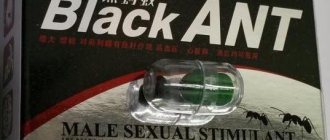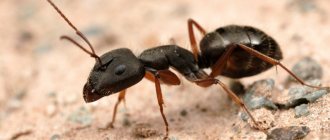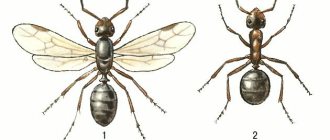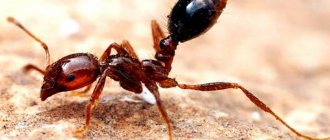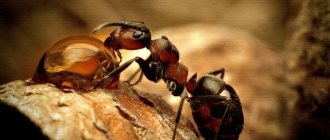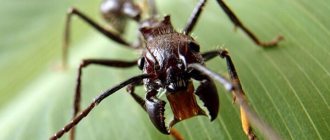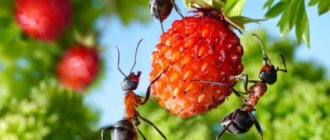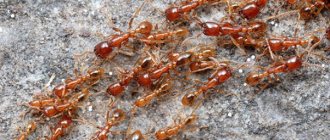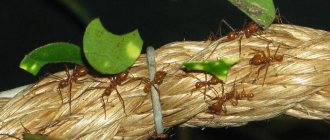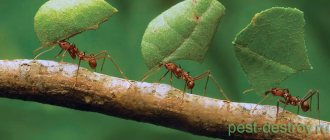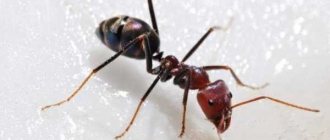Insects scurrying around the kitchen are an unpleasant occurrence. Once ants enter a house, they quickly spread throughout the room; they can be found in any food, even tightly closed ones. They penetrate inside household appliances, disabling them. Many people find the appearance of pests unpleasant. Black ants also bite painfully. Getting rid of ants is not easy. Why did big black ants come into your house and how to deal with them?
Appearance
If a person is asked to describe an ant, he immediately characterizes this species:
- The body is divided into 3 segments, the head and abdomen stand out well.
- The head has long antennae, the whole body is covered with villi.
- Three pairs of legs, allowing the insect to move quickly and crawl to the greatest heights.
- Color – dark brown, black.
The anthill contains insects with different body lengths. The largest is the uterus. The fertile female reaches a size of 13 mm. The smallest workers are females incapable of fertilization. They grow up to 4 mm. Males are 1 mm larger, young females are 7 mm. A photo of black ants is presented below.
Black garden ants
Interesting!
During the mating season, males and females grow wings. This is not a separate species of flying ants, but just a temporary transformation. The males soon die, the queens look for a convenient place, burrow into the ground, and lay eggs. Within a month, workers grow from them and begin building and arranging the anthill.
Black carpenter ant (Camponotus vagus): distinctive features
Black carpenter ant (Camponotus vagus), appearance
An insect can be identified by color and size. Despite this, representatives of this species are often confused with other ants that live in forests. The insect also has an extremely similar physique to its close relative, the red-breasted carpenter ant.
External characteristics
The black carpenter ant (Camponotus vagus) is large in size: the body length of females is 1.5-1.7 cm, soldiers are slightly smaller than females, males are 1-1.2 cm, workers are 0.6-1.3 cm The color is black, shiny, without any admixtures of other shades. The antennae are geniculate. The eyes are medium-sized, black. The head is large and wide. There are light silvery hairs on the abdomen. The lower edge of the clypeus is straight.
The eggs are small and have an elongated shape. The color is white, often with a slight hint of yellow. Insect larvae have pronounced segmentation. The body color is similar to the eggs. The body is shiny, translucent.
Spreading
The black carpenter ant lives exclusively in forests. This insect can be found in Europe and Northern Asia: in the Crimea, Western Siberia, Kazakhstan, Turkey, the Urals, and the Caucasus. It also lives in northwest Africa.
Under unfavorable conditions, ants hide in underground passages. They prefer deciduous trees. The largest populations are seen in places with high humidity.
Housing
Black ants build several types of nests. In most cases, it is a cone-shaped form, formed from a mound of earth, covered with twigs, needles, and leaves. The anthill has many passages, chambers, warehouses, and is divided into 2 parts. Large black ants spend most of their time in the upper floors. They live until the onset of cold weather. At the bottom, deep underground, they spend the winter.
The second housing option is old wood, stumps. Lasius niger ants gnaw wood and mix it with saliva. Used as a building material. The tree is formed by numerous passages, exits, and chambers. Long underground tunnels and mines extend from them.
You can see the nest directly in the soil, with holes, loosened soil without a characteristic mound. Lasius niger ants also settle under stones and branches. Insects settle in fields and vegetable gardens, but most of all they love orchards. Because of this, they are also called garden black ants.
Ant Size Range
The sizes of ants vary widely - from 1 to 55 mm or more. For example, the length of working individuals of the genus Monomorium does not exceed 2 mm. And in the genus Camponotus gigas there are truly gigantic ants: the length of representatives of the working class can reach 20 mm, males - 18 mm, soldiers - 28 mm, and queens - 31 mm.
Ants of the genus Paraponera clavata are also among the largest in their family. The dimensions of some of them can reach up to 30 mm. Bulldog ants are frightening not only for their size (up to 25 mm for workers, up to 20 mm for males and up to 30 mm for the queen), but also for their ability to sting with deadly poison.
The largest representatives
The largest living ant, according to entomologists, is an African male belonging to the genus Dorylus. Its size is about 3 cm. The uterus of this species during the period of maturation increases in length by 5 cm.
Of the ants that previously inhabited the Earth, giants include representatives of the genus Formicium. Females of this genus reached 7 cm in length, and their wingspan was 15 cm.
Ants of the Titanomyrmalubei species lived in the United States more than 50 million years ago. The size of their uterus corresponded to the size of a hummingbird. This is the largest ant ever seen in the world.
Features of bulldog ants
Bulldog ants are very large members of the family. There are now about 90 species. The following features of these insects can be distinguished:
- The bites of some representatives are dangerous due to the venom, which, as a rule, causes severe pain in a person or animal that does not go away for several days.
- After a bite, a person may experience an allergy and then anaphylactic shock, the consequences of which are most often sad.
- The composition of the venom of these insects is very similar to that of aspen and bees. Its components are oligopeptide, hyaluronidases, and histamine.
- These large ants are characterized by the presence of sharp and long multi-toothed stingers.
- All individuals have different eye colors - black, yellow, orange, red. The eyes are located on the head - in the front part of it.
Like their cousins, bulldog ants build anthills and live in colonies consisting of hundreds or even thousands of individuals. The home is guarded around the clock, and it is very difficult for other insects to enter it. In addition, excellent vision allows ants to notice their enemies from afar.
Reproduction
The mass flight of young females and males from the nest occurs in June. Fertilization occurs in the air and lasts about a week. Each female tries to establish her own nest and does not return to her previous place of residence. If she fails to do this, she may return to the previous anthill.
The queen of black ants lives for about 28 years. Lays eggs every week. They are taken by worker ants performing duties inside the anthill. Then they take care of them themselves. Provide optimal conditions and turn over. Move from cell to cell as necessary.
Interesting!
After 2 weeks, larvae emerge from the eggs in the form of white worms. They are unable to move, feed on their own, and are blind. The future life of the ants depends on how the adults feed the larvae. Within a month, the larvae pupate and emerge from the cocoon as full-fledged young black ants. Some become builders, others become nannies and midwives, others become security guards, soldiers, etc. There are more than 15 professions in the ant family.
Long-lived queens
Although worker ants live for at least four years, queens can survive for almost 30 years. Understanding the basis for greater queen longevity is relevant to a general unresolved problem in the biology of the causes of aging. In a study of long-lived queen ants, it was discovered that queens have higher expression than genetically identical worker genes involved in processing damaged macromolecules. Genes with higher expression levels included those required for DNA damage repair (see DNA damage theory of aging) and genes involved in proteasome-mediated, ubiquitin-dependent, protein catabolic processes.
Nutrition
Large black ants in the garden find food for themselves, their larvae. Adults feed on plant juices, a sweet secretion secreted by aphids. To obtain food, ants spread aphids throughout the garden, providing them with the most succulent trees in the country. Behind it they collect honey dew.
Ants' habitat
Interesting!
Black ants keep aphids in their home in a special chamber. They provide her with adequate nutrition, tickle her with antennae, and receive a sweet delicacy.
The larvae are more voracious. They need protein foods. Adults bring them insects, worms, and slugs. These feeding habits make black garden ants useful and harmful. Insects will destroy small pests and spread aphids themselves, causing significant damage to crops.
Causes of black ants
Residents of nature can move into people's homes. The main causes of pests include:
- penetration from attics and through ventilation shafts;
- enough food and nourishment;
- active struggle between neighbors - ants are looking for new places in this case;
- comfortable warm temperature in living areas;
- the possibility of penetration of flying individuals through the window;
- lack of regular cleaning.
Behavior
The garden black ant is a non-aggressive creature, but endowed with a sting with poison. They use their weapons during hunting, when enemies attack, or when danger approaches. The insects bite quite hard, leaving an inflamed red mark. For a person prone to allergies, an ant bite can cause serious health problems.
Interesting!
There are always several adults guarding order. In case of danger, they give a signal to the others and attack the enemy en masse. In an instant, a whole colony of insects appears on the foot of a person who steps next to an anthill.
An insect will not just bite. He will crawl freely along his arm and leg if he is not in danger. The slightest pressure on the body leads to a defensive reaction.
On a note!
In nature, there are a huge number of giant black ants that can bite domestic animals to death and cause significant damage to human health. This type of ant lives in tropical countries. When insects infest, residents leave the house, taking their entire household with them.
Prevention
Hornets - how to get rid of them in the house
So that you don’t have to think about how to deal with winged ants in a private home, it is easier to prevent their appearance. To prevent flying ants from appearing in your house again, you should follow simple recommendations:
- The foundation of the house must be treated with a solution of creosotome, prepared according to the attached instructions for use. Thanks to this, it will be possible to create a protective barrier through which insects will not penetrate.
- Sprinkle a small amount of cinnamon, talcum powder, and ground pepper in front of the front door.
- Prepare a concentrated soap solution and pour it into a spray bottle, then use it to treat window openings and door jambs.
- Seal all cracks in the walls with sealant.
- Ants love sweets, so confectionery products should be stored in hermetically sealed containers. After preparing and eating food, you need to remove crumbs and wash dirty dishes.
- Bring forest ants into the house. They do not live indoors and will leave on their own, but only after they have eaten the house inhabitants.
- Prepare an effective remedy from any jam, boric acid and nutritional yeast. Mix everything thoroughly and place it in places where insects are often found.
- Add detergent to a spray bottle and use the resulting concentrated solution to irrigate surfaces in the house.
- It is recommended to place coffee grounds in places where flying insects accumulate.
- Place aromatic herbs around the room, such as wormwood, elderberry and mint.
- Pour ant passages generously with vegetable oil or garlic juice.
- To prevent insects from reaching the food on the table, you will need to wrap the legs of the table and chairs with fly catching tape or foil. Ant
To prevent the reappearance of insects, it is necessary to use the following products: boric acid, fresh yeast, vinegar and corn flour. Each component is effective on its own, but to achieve maximum results it is better to mix them.
Flying ants should arouse increased interest among household members, since these are the representatives who are ready to reproduce. If they are not addressed immediately, the problem could become much larger.
Sources
- https://notklop.ru/muravi/vidy-muravev/chernye-muravi/
- https://domvred.ru/chernyj-muravej-drevotochec/
- https://comp-plus.ru/uborka/chyornye-muravi-sadovye-drevotochtsy-i-domashnie-muravi
- https://apest.ru/muravi/vidy-muravev/chernye-muravi/
- https://FB.ru/article/252695/lesnyie-muravi-vidyi-opisanie-polza-i-vred
- https://TaraKlop.ru/muravi/sadovye-chernye-muravi/
- https://stroy-podskazka.ru/dom/vrediteli/chernye-muravi/
- https://GdeKlop.ru/muravi/izbavitsya-ot-sadovyh/
- https://vermins.net/muravi/muravi-s-krylyami.html
- https://antivrediteli.ru/chernye-muravi
- https://7ogorod.ru/prochee/muravi-s-krylami-v-dome.html
Fighting methods
Ant control
The garden ant is not dangerous until it begins to spread aphids. If there are no aphids in the garden plot, there will be no large anthills on the territory of the summer cottage.
Control methods include the use of folk and professional remedies. The choice of methods depends on individual preferences, the number of insects on the site, the location of the anthill, and the number of individuals.
- Trees are sprayed with soda solution against aphids. To make the soda stay on the leaves longer, add soap and linseed oil to the water. It is necessary to spray every week in the warm season.
- The anthill is filled with a bucket of boiled water and a solution of boric acid. They practice the method of setting fire if the nest rises above the ground. They douse it with a flammable liquid, often kerosene, and set it on fire. It is better to do this in the evening, when all the working ants return home.
- You can expel all the inhabitants from an anthill with the head of a herring, placing it on top of the building.
- Bushes of mint, lemon balm, and calendula are planted in the garden. Black garden ants cannot tolerate the smells of these plants.
- One of the most effective remedies for ants and aphids is garlic. They rub it on tree trunks and tie them with garlic arrows.
- The trees are protected with trapping belts made of polyethylene. An adhesive substance is applied to them - resin, tar, grease. Or buy special garden glue against ants.
Insects are afraid of drugs in the form of a gel. It contains a broad-spectrum insecticide, fragrances, and flavoring additives. Insects eat themselves, carry poison into the nest, feed the larvae and the queen. Mass death occurs within 14 days. The most common remedy is Great Warrior.
Relationship between ants and people
Surely, if you have a summer house, then you have encountered such a problem as ants in the garden.
The vegetable garden or flowers suffer greatly from ants, because the ants simply eat various berries and herbs.
Summer residents have already put forward many ways to combat such garden parasites.
Danger to people
0 Crawling somewhere on rotting food debris and sewage, and then getting on food, ants are able to act as carriers of all kinds of human diseases: diphtheria, typhoid, etc. Any food product can suffer from an ant invasion. The secretive placement of nests and the inability to effectively use contact poisons to reduce their numbers seriously complicate the fight against these insects. Usually the most effective method is the bait method, which is based on the characteristics of a given biological species to transfer its food from the mouth of one individual to the mouth of others that are in the nest.
Indications for use
Most pills of this type are designed to increase erection per sexual act. However, manufacturers claim that this drug is not needed to mask impotence, but to treat sexual problems. The product can be used both for a single session of sex (to increase the duration and improve the quality of sexual intercourse) and for the treatment of erectile dysfunction.
The product is used if a man has the following problems:
- impotence;
- prostatitis;
- premature ejaculation;
- enuresis;
- chronic fatigue;
- Oligospermia.
It is better not to prescribe this drug on your own. If it is necessary to treat enuresis or other diseases of the genitourinary system, it is first recommended to consult a urologist for advice.
Myrmiki lifestyle
However, the insects themselves are capable of an aggressive attack only if their anthill in the forest is damaged. Myrmikas build nests on the ground, under pebbles and in tree stumps and moss hummocks. Their families number from 10 to 12 thousand individuals. At the same time, there can be up to one hundred egg-laying females. Members of one family live in several nests, which are connected to each other not only by ground paths, but also by underground passages. Some of these “houses” are permanent, they are inhabited all year round. Other buildings are seasonal; insects use them only in the summer. Before wintering, all members of the huge family move to large permanent nests.
Small ants use their summer quarters to raise numerous larvae, pupae and root aphids.
Myrmics hunt small invertebrates, eat flower nectar, and grow colonies of aphids on plant roots. Scout ants search for food. Having found food, they leave scent trails, then return to the anthill for help and correctly lead out their fellows according to their own marks.
Useful materials
Below you can find articles that may be useful and interesting to you:
- Destruction of ants:
- How to get rid of red ants in an apartment?
- Boric acid and borax for ants
- Folk remedies for ants in the apartment and house
- Rating of effective remedies for ants in the apartment
- Ant Traps
- Ants in the garden:
- Types of ants
- How do ants winter?
- Who are the ants?
- What do ants eat?
- The meaning of ants in nature
- Hierarchy of ants: king ant and structural features of the worker ant
- How do ants reproduce?
- Ants with wings
- How to get rid of ants in the garden?
Why are garden ants dangerous?
The experience of summer residents shows that the ant is one of the most resilient insects. Not all methods of control turn out to be truly effective - it is worth preparing for the fact that after the first treatment the colony, although it will suffer losses, will not leave the area.
Moreover, in a biological sense, ants are an extremely interesting insect. They are characterized by a kind of “livestock keeping” - as “cows” they contain aphids, which are also a pest for green spaces. They “graze” their livestock, protecting them from insects that feed on aphids, and even “milk” them - they rub their paws against the abdomen of the aphids, which in turn secretes a substance that the ants drink with pleasure. This symbiosis can have a truly destructive effect on green spaces and crops growing in the country.
It is important to know! It is necessary to differentiate forest ants from garden ants - we were taught from childhood that the former are forest orderlies - and they really have a positive impact on the environment by eating carrion. Garden ants are considered pests that breed aphids. In addition to red soil ants, you can find brown, turf, and red-cheeked ants on your plots - the listed representatives are 100% pests; in the absence of measures to eliminate them, ants are capable of destroying crops in a relatively short period of time.
Capture
Let's say you're lucky and you see a queen crawling on the ground. If she has not shed her wings yet, it is better to leave her alone, she may not be fertilized yet. We only need queens that have already shed their wings - they will definitely be somewhere nearby. If you see one, then you can put it in the incubator.
Never grab the uterus with your hands! You can easily damage its legs or abdomen. She needs to be driven into the incubator, you can use improvised objects - adjust and guide the queen with a blade of grass, or a thin twig, or a piece of paper. The main thing is not to damage! If you don’t have an incubator with you, you can use another container to bring the queen home, but you don’t need to drag it, but move her to the incubator as quickly as possible. After that, try to identify the species. If it is a social parasite, release it; if the queen establishes a colony on her own, remove the incubator to a dark, quiet place and do not disturb it. Check back carefully in a couple of days - most likely she will already have a clutch of eggs. Now all that remains is to wait - it is advisable not to touch the queen at all for several weeks, every time you look in may result in the brood being eaten, and you will have to wait from the beginning.
Uterus Serviformica cunicilaria in vitro
What to do if bitten by ants?
And finally, let’s talk about ant bites, because in the fight against them you yourself may suffer. An ant bite is not dangerous to humans, but can cause severe itching and sometimes even an allergic reaction. During an allergic reaction, blisters appear and the skin swells. An allergic reaction is accompanied by nausea, dizziness, and sometimes even loss of consciousness.
If you nevertheless suffered in an unequal battle with ants, then the first thing you need to do is take antihistamines and put an alcohol compress on the affected areas. For a compress, you can use a soda solution or potato decoction.
First encounter with the enemy
Types of ants
Red myrmica
There are more than 13 species of ants in the world and each of them has its own way of life.
Most of the species live in tropical regions of the world, but we also have plenty of this living creature: about 200 species live in Russia and about 40 in Moscow and the Moscow region.
Russian ants belong to one of the subfamilies - formycin and myrmicine.
Formicines defend themselves from attacks by enemy insects and humans with the help of formic acid, but myrmicines “bite” their enemies with a special sting (and such a bite is very painful even for humans).
Let's take a closer look at the most common types of formicin and myrmicin.
Red myrmica is a medium-sized myrma with a reddish-brown or straw-yellow body. It is he who often likes to settle in gardens and vegetable beds.
The second most common myrmicine is the sod ant. It is smaller than the red myrmic and has a black or dark brown body. This species prefers dry sandy soils.
Many townspeople encountered another representative of the myrmicine - the pharaoh ant - in their apartments. The tiny wretch accidentally came to Europe from tropical countries more than 200 years ago. In a short time, he firmly settled in city dwellings, where he was comfortable, well-fed, and warm.
The main difference between formicin and other types of ants is the shape of the breast. If you look closely at the abdomen of this arthropod through a magnifying glass, you will notice that it is divided into three parts.
The largest of the domestic species is the carpenter ant, whose length reaches 1.4 centimeters. The head and belly of this ant are painted black, but the chest is red or reddish in color. The woodborer sometimes chooses old stumps or logs in the garden as its home.
In summer cottages you can most often encounter black garden or brown forest ants. The first of them is able to survive even in urban conditions - in flower beds, parks and cracks in the asphalt. The length of its blackish-brown body is only 3-4 millimeters. Its forest counterpart is slightly larger - its size varies from 3.5 to 7.5 millimeters.
You've probably come across large ant heaps of pine twigs and needles in the forest. Their inhabitant and builder is the red forest ant. This species extremely rarely migrates from the forest to garden plots or people's houses.
Ant matriarchy
Pharaoh ant
Almost all ants live within a strict hierarchical system - workers, queens and brood.
Those ants that usually catch our eye are ordinary hard workers or infertile females. They are incapable of reproduction, therefore the list of responsibilities of such individuals includes obtaining food, protecting and improving the colony, as well as caring for the brood.
In some cases, within the working class there is also a division into separate subclasses. Working individuals with a powerful physique act as soldiers. Their functions include protecting the ant house and storing liquid food reserves in special crops, for the extraction of which small working ants are responsible.
The most important and protected member of the ant house-building is the queen, a fully fertilized female.
Externally, it differs from ordinary worker ants in that it has a more massive abdomen and a slightly different sternum structure. The queen spends most of her life deep underground, where she is jealously guarded by workers. The main and only calling of the queen queen is to lay eggs.
Red-breasted woodborers and turf borers contain only one fertile female per colony. Her death means the death of the entire colony.
Black garden ant
However, the red forest ant, the red mimrik and the pharaoh ant even have an excessive number of queens - in the first species they number in the hundreds and sometimes thousands, and in the remaining two - in the tens.
The total number of individuals in families of different types of ants also varies - for example, in Mimics this number reaches 5 thousand hard workers, but in the nest of a red forest ant up to a million voracious pests can live.
The main task of an ant colony is to ensure the survival of its offspring, or brood, which includes eggs, larvae and pupae. Ant eggs are very tiny, less than one millimeter in diameter. Working individuals combine them into separate “batches”, which are then dragged into the compartments of the nest with the most favorable temperature and humidity. They treat the larvae in the same way.
The developed larvae are separated and distributed into separate chambers, where they lie on the floor or are suspended from the ceiling and walls. In Formicines, before pupation, the larvae are wrapped in a hard whitish-yellow shell. It is these mini-cocoons that we usually mistake for ant eggs.
Once a season, winged young females and males emerge from the ant nest. Winged individuals from different families form a swarm in which mating takes place. After this, the males die, and the fertilized females get rid of unnecessary wings and begin to run along the ground in search of a reliable shelter. Some of them become dinner for birds, predatory insects and toads, and those who are lucky find a new home and start a family.
In fact, ants are truly amazing creatures. See for yourself by watching a short video.
As a pest
In the garden
This type of ant is a problem for some gardeners. They will cultivate aphids and scale for the honeydew they excrete, causing them to move away from the host plant to host the plant and spread these other garden pests to new healthy plants. Ants also eat ripe fruits, especially fruits such as strawberries that do not have a thick protective shell. Lasius Nigeria
also feed on insects and spiders, and other small invertebrates.
Taxonomy
The species is included in the nominative subgenus Lasius s.str. It was first described in 1758 by the Swedish naturalist Carl Linnaeus under the original name Formica nigra Linnaeus, 1758 for the working caste. Females and males were described in 1798 by the French entomologist Pierre Latreille (Latreille, 1798). Later, by different taxonomists, it was included in the genera Lasius
(Fabricius, 1804),
Donisthorpea
(Donisthorpe, 1915),
Formicina
(Emery, 1916),
Acanthomyops
(Forel, 1916) and again in
Lasius
(Menozzi, 1921). Within the species there are two subspecies (EOL):
- Lasius niger niger (Linnaeus, 1758)
- Lasius niger pinetorum Ruzsky, 1907
Contraindications
The drug has undergone many clinical trials, which have confirmed that it is completely harmless. But the drug should still not be taken by people with psychological illnesses and diseases of the cardiovascular system, since the drug contains components that have a strong effect on these areas of the body.
Sometimes individual intolerance to certain components of Black Ant can be detected. In such a situation, it is recommended to consult a physician for consultation to determine the advisability of continuing treatment with this drug.

